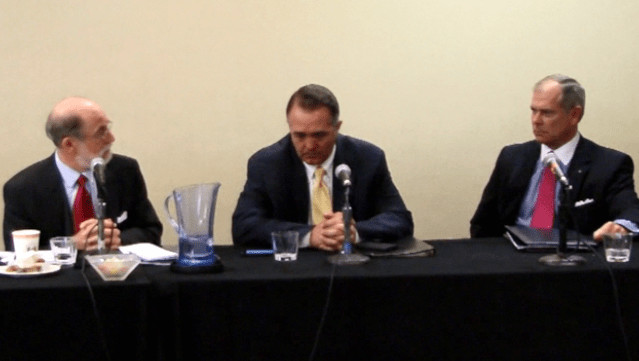Symposium on Law, Policy and Innovative Technologies in National Security
UAVs and Electromagnetic Pulse (EMP)

On the morning of the Keeper of the Flame Award Dinner – paying tribute to the life of Congressman Bill Young – the Center convened two expert panels to discuss two areas of technological development in the field of national security: Unmanned Aerial Vehicles (UAVs) and the phenomenon of Electromagnetic Pulse (EMP). Video of the event follows.
Unmanned Aerial Vehicles (UAVs): Legal, Policy and Innovation Trends
Moderator — Frank J. Gaffney Jr, CSP
Speakers:
- Rep. Joe Heck (R-NV), Chairman, Subcommittee on Technical and Tactical Intelligence, House Permanent Select Committee on Intelligence; Member, House Armed Services Committee; Member, UAV Caucus
- Dr. Michael Keegan, President of the DC Capitol Chapter of the Association of Unmanned Vehicle Systems International (AUVSI). Dr. Keegan has worked on numerous high profile programs within Northrop-Grumman including Global Hawk and Triton. He currently works within the Ground Systems Business Unit in the Intelligence Systems Division.
- Col. Bill Tart, director, RPA Capabilities Division (AF/A2CU), U.S. Air Force
- Ben Lerner, Esq., Center for Security Policy
For the past several years, both the Bush and Obama administrations have deployed unmanned aerial vehicles (UAVs) with increasing technological sophistication to eliminate terrorist leaders and operatives abroad, with substantial success. This use of UAVs for both surveillance and lethal force continues to be threatened by international legal and political efforts to eliminate their use. If successful, these efforts could have serious ramifications for the use of UAVs for the remainder of the Obama administration and beyond.
In parallel to the release of its forthcoming study exploring the technology, legal and policy landscape informing this debate, the panel’s experts from government and industry will discuss trends in international law, policies and politics for UAVs, the national security impacts of stricter rules governing the use of UAVs abroad, the extent to which advances in UAV technology may drive changes in law and policy, and related topics.
Securing America from Electromagnetic Pulse (EMP): Technical and Policy Challenges
Moderator — Frank J. Gaffney Jr., CSP
Speakers:
- Brigadier General (ret.) Ken Chrosniak, Member of EMPact America, a firefighter with Carlisle Fire Rescue, VP of Cumberland Goodwill Ambulance (EMS) Company, and member of the FBI vetted InfraGard EMP Special Interest Group. Ken is an instructor at the Army War College’s Center for Strategic Leadership Development.
- Rep. Trent Franks (R-AZ), Chair, Congressional Electromagnetic Pulse Caucus; Member, Intelligence, Emerging Threats, and Capabilities Subcommittee; Member, Strategic Forces Subcommittee.
- Major General (ret.) Robert Newman, Former Adjutant General of Virginia; Deputy Assistant to the Governor, Virginia; Vice Director of Operations & Logistics at US Joint Forces Command ; Deputy Director of Homeland Security at National Guard Bureau.
The backbone of the United States and its 21st Century society is our electric grid. Without it, every critical infrastructure — including food, water, medicine, telecommunications, finance and transportation — would be inoperable, with catastrophic consequences for many millions of Americans whose lives would be imperiled by the loss of such services.
Unfortunately, the U.S. bulk power system is presently vulnerable to widespread damage and possible destruction from a variety of sources. Arguably, the most serious of these is electromagoetic pulse (EMP), whether induced by natural phenomena (i.e., solar flaring and the resultant space weather) or enemy actions (e.g., localized attacks on the grid’s critical nodes- roughly 1,000 transformers- involving radio frequency weapons or strategic attacks utilizing exoatmospheric detonations of nuclear weapons). Either could have the effect of blacking out large parts of the United States for protracted periods of time.
This panel will consider the emerging consensus that such threats are real and must be remediated; examine how best to make the present and future grids resilient against these and related dangers (including cyber-warfare); and address the necessary federal-and state-level legislative and executive branch actions required to effect such changes.
- Frank Gaffney departs CSP after 36 years - September 27, 2024
- LIVE NOW – Weaponization of US Government Symposium - April 9, 2024
- CSP author of “Big Intel” is American Thought Leaders guest on Epoch TV - February 23, 2024
